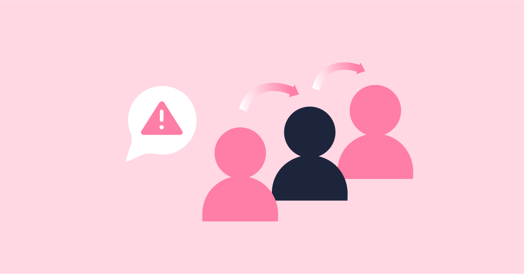Have you ever called a customer service department only to be passed from one customer service agent to another while waiting for long periods in between? It’s frustrating, isn’t it? Plus, you’ve probably better things to do with your time. Ticket bouncing is the equivalent of this experience with IT support. It’s also known as ticket reassignment. It’s where an IT incident or service request ticket is passed from one service desk agent or team to another before it’s finally resolved or provisioned against.
End-users might be held on the phone waiting. Still, they’re even more likely to experience a delay in getting to their desired outcomes. That mounting frustration you feel while waiting on the customer service line? It’s the same for IT end-users. Perhaps worse, because the delay might be preventing them from working.
Experience data shows ticket reassignments directly reduce end-user happiness and productivity
We’ve learned this statement from millions of IT end-user feedback responses. Because the HappySignals Experience Management Platform links end-user feedback with IT service management (ITSM) tool operational data, it can measure the adverse impact of ticket reassignments on employee happiness and productivity. As reflected in the Global IT Experience Benchmark Report H1/2023, 34% of all tickets get bounced at least once.
More importantly, as shown in the above image, end-user happiness and productivity decrease dramatically each time a ticket is reassigned. With each additional bounce, end-user happiness reduces by an average of close to eight points, and end-users perceive themselves to lose an average of 1 hour and 42 minutes of work time. When a ticket is reassigned or bounced four times, the IT support interaction results in an average perceived total work loss of 8 hours and 22 minutes!
Our experience data, collected over the past eight years, has shown a consistent trend in the frequency of ticket reassignments and the corresponding adverse impact on end-user happiness and lost time. This is one of the most visible areas where IT experience data can help IT teams achieve quick wins in increasing end-user productivity by ensuring incidents are directed to the right teams as soon as possible. But how does IT do this?
Addressing the impact of ticket reassignments
Understanding why and reducing ticket reassignments is crucial for IT to enhance end-user happiness and productivity. For our customers, it’s one of their most significant metrics.
In addressing the level of bounced tickets and their impact, there’s first a need to identify ticket bounces and measure the associated employee experiences. Then, pinpoint the primary causes of ticket reassignments, determining which ticket types are most bounced and the underlying reasons. The next step is to consider the process modifications or automation that can be implemented to expedite the routing of these tickets to the appropriate agents.
A practical approach to minimizing ticket reassignments
IT organizations can utilize HappySignals reassignment data to create robust business cases demonstrating the productivity benefits of implementing improvements to reduce the adverse impact of ticket reassignments. You can start by measuring the effect of ticket reassignments on end-users and identifying the key causes of ticket reassignments in your organization.
In the example below, I look at tickets with three reassignments. In the sample data, many of the tickets reassigned three times relate to Salesforce and Workday.

You can find ways to reduce ticket bounces for these areas from this insight. Once you start identifying where and why the reassignments frequently occur, you can automate parts of the process to get the tickets to the right agents without reassignments.
Tackling the underlying causes of the unnecessary ticket reassignments will enable your IT team to provide a more seamless service experience for end-users and return hours of employee productivity to the business.
If you’re interested in how HappySignals measures and helps customers understand ticket reassignments, please watch this episode of Happy in 15, where I give a more extensive demo! Or please refer to this helpful cost-focused reassignment article.
Mitigating the negative impact of ticket reassignments
Even if reassignments are impossible to eliminate, you can still make small but effective changes to the service experience for end-users. For example, end-users are often frustrated when they’re not updated about the progress of their tickets. So, each time a ticket is bounced, IT could send the end-user a message informing them that their issue is being reassigned to an expert team for resolution.
Simple, easy-to-implement changes like these can make a huge difference to end-user perceptions of IT support!
The link between bounced tickets and end-user happiness and productivity is too strong to ignore
Our experience working with IT departments in different organizations has shown us that ticket reassignment significantly affects end-user happiness and productivity, and we believe it could be one of the most important IT metrics to improve.






